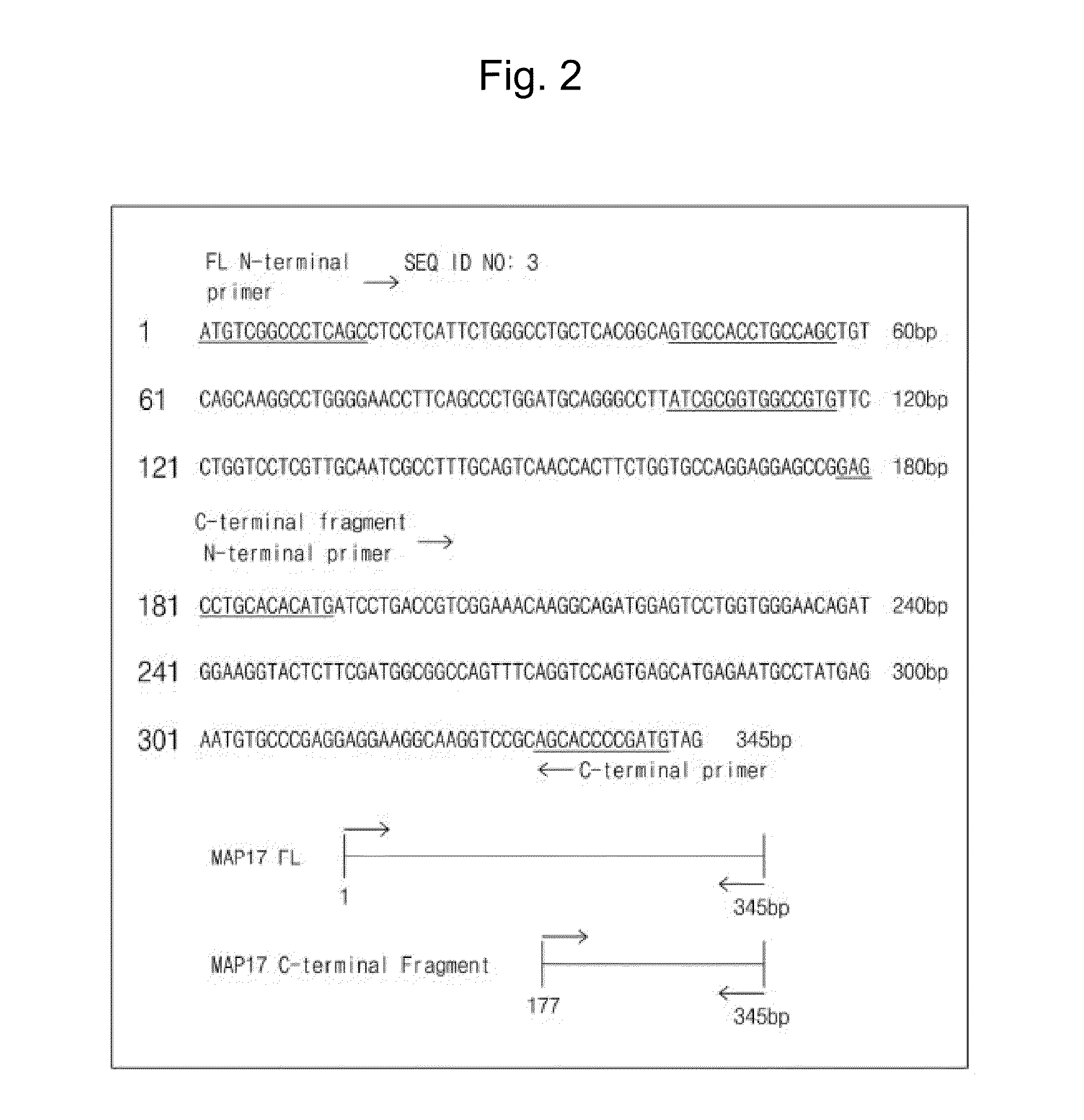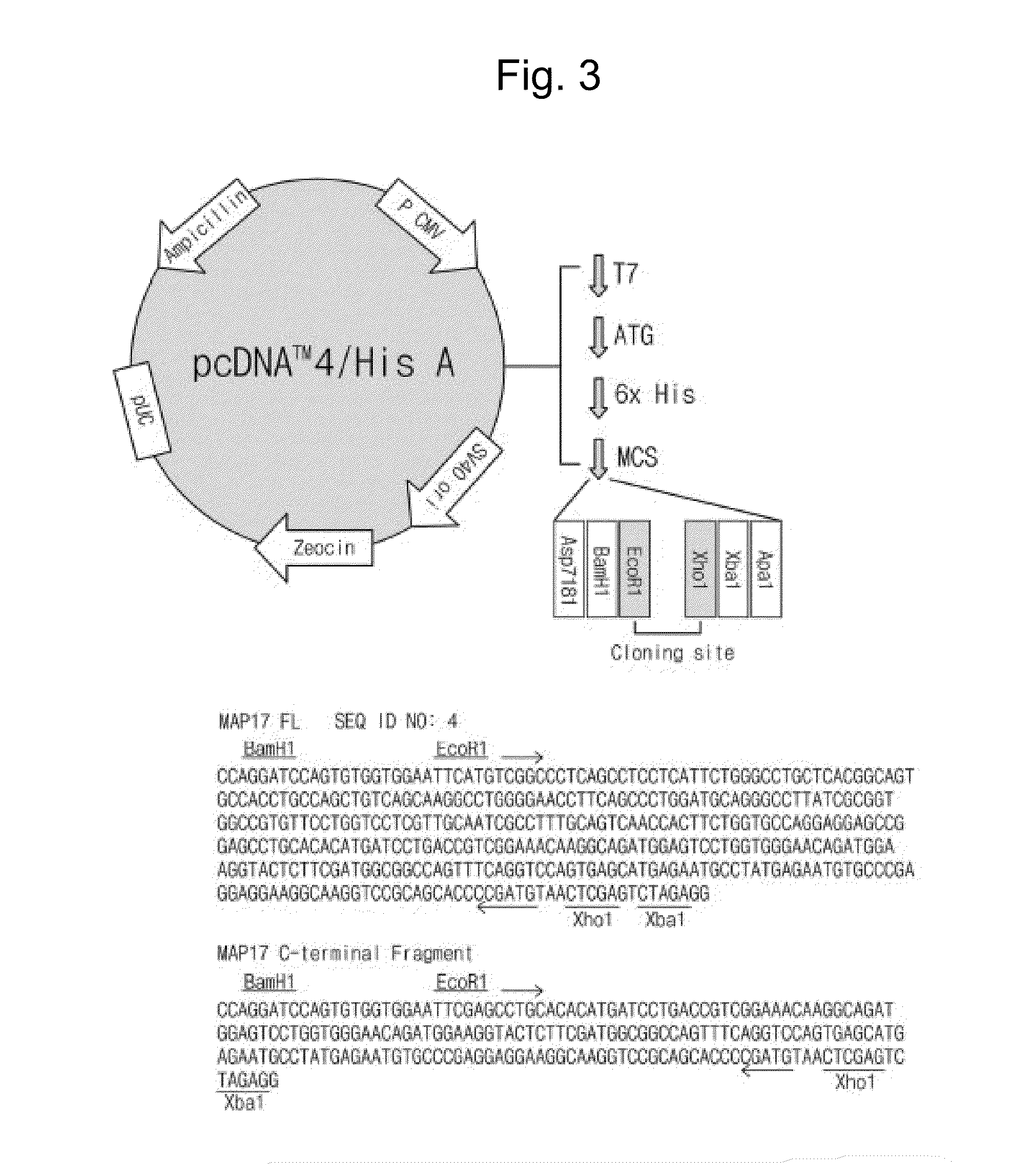Method of screening material for improving skin functions
- Summary
- Abstract
- Description
- Claims
- Application Information
AI Technical Summary
Benefits of technology
Problems solved by technology
Method used
Image
Examples
example 1
Change in Expression of MAP17 Gene by Inflammation-Related Interleukins
[0042]Human keratinocytes (human epidermal neonatal keratinocyte cells) were purchased from Lonza, Inc. (Walkersville, Md., USA) and subcultured according to the manufacturer's recommendations. The cells were incubated in a CO2 incubator under a condition of 37° C. and 5% CO2. Cell culture was prepared according to the instructions of Lonza, Inc. KGM-2 bullet kit [bovine pituitary extract (BPE, 2 mL), human epidermal growth factor (hEGF, 0.5 mL), insulin (0.5 mL), hydrocortisone (0.5 mL), transferrin (0.5 mL), epinephrine (0.5 mL), gentamycin sulfate+amphotericin B (GA-1000, 0.5 mL)] was added to KBM-2 (Clonetics CC-3103) medium (500 mL).
[0043]The cultured human keratinocytes without any treatment were used as a control group. For test groups, the human keratinocytes were further cultured for 24 hours after adding IFN-γ (200 units / mL), or IL-4, IL-6, IL-17A, IL-17F or IL-22 (50 ng / mL). The interleukins derived fr...
example 2
Quantification of Expression of Filaggrin Gene Due to Overexpression of MAP17
[0045]Clones having MAP17 gene (Clone id: hmu001988) were purchased from Korea UniGene (21C Human Gene Bank, Genome Research Center, KRIBB, Daejeon, Korea). In order to express the MAP17 gene in mammalian cells, full length MAP17 (SEQ ID NO: 3, 1-345 base pairs, 115 amino acids) and carboxy-terminal (C-terminal) fragment (177-345 base pairs of SEQ ID NO: 3, 55 amino acids) were amplified by polymerase chain reaction (PCR). The N-terminal primer of the full length gene was 5′-GAA GAA TTC ATG TCG GCC CTC AGC-3′ (SEQ ID NO: 5), including the EcoR1 restriction enzyme site. And, the N-terminal primer of the C-terminal fragment was 5′-GAA GAA TTC GAG CCT GCA CAC ATG-3′ (SEQ ID NO: 6), including the EcoR1 restriction enzyme site. The C-terminal primer of the full length MAP17 gene and the C-terminal fragment was 5′-GAA CTC GAG TTA CAT CGG GGT GCT-3′ (SEQ ID NO: 7), including the XhoI restriction enzyme site. PCR m...
example 3
Confirmation of Regulation of Expression Level of MAP17 and Filaggrin Genes by Ginsenoside-Re
[0049]Various human keratinocytes were treated with a variety of materials, and change in expression of MAP17 and filaggrin genes were monitored. It was investigated whether ginsenoside-Re, a kind of ginsenoid derived from the fruit of ginseng, regulates the expression of MAP17 and filaggrin genes. Human keratinocytes were purchased from Lonza, Inc. and cultured in KBM-2 medium (Clonetics CC-3103) in a CO2 incubator under a condition of 37° C. and 5% CO2.
[0050]The cultured human keratinocytes without any treatment were used as a control group. For a test group, the human keratinocytes were further cultured for 24 hours after adding ginsenoside-Re (10 uM). Ginsenoside-Re was purchased from Wako (Kanagawa, Japan) and prepared into a solution according to the manufacturer's instructions. 24 hours after the ginsenoside-Re treatment, the cells were washed twice with 10 mL of PBS and total RNA was...
PUM
| Property | Measurement | Unit |
|---|---|---|
| Level | aaaaa | aaaaa |
Abstract
Description
Claims
Application Information
 Login to View More
Login to View More - R&D
- Intellectual Property
- Life Sciences
- Materials
- Tech Scout
- Unparalleled Data Quality
- Higher Quality Content
- 60% Fewer Hallucinations
Browse by: Latest US Patents, China's latest patents, Technical Efficacy Thesaurus, Application Domain, Technology Topic, Popular Technical Reports.
© 2025 PatSnap. All rights reserved.Legal|Privacy policy|Modern Slavery Act Transparency Statement|Sitemap|About US| Contact US: help@patsnap.com



